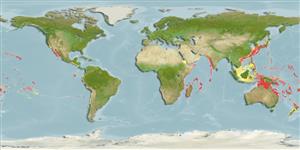Common names from other countries
Environment: milieu / climate zone / depth range / distribution range
Ecologia
marinhas associadas(os) a recifes. Tropical
Western Pacific: Japan to Australia and the Kermadec Islands. Recently reported from Tonga (Ref. 53797).
Tamanho / Peso / Idade
Maturity: Lm ? range ? - ? cm
Max length : 5.0 cm TL macho/indeterminado; (Ref. 2334)
Raios dorsais moles (total) : 12 - 43; Raios anais moles: 22 - 40. Body fully scale. At least some of the dorsal saddles reaching a distinct lateral band. Combined number of soft rays in dorsal and anal fins usually 49 to 55 (Ref 12874).
A cryptic species that occurs on sandy or gravel bottoms. Pointed snout is used for burrowing; eyes directed upwards for sighting prey. Found from shallow tide pools to at least 150 m (Ref. 2334). Eyes move independently and possess a refractive cornea, a convexiclivate fovea and a non-spherical lens (Ref. 50869). Neither cleitheral spine gland nor anterolateral glandural goove with gland is present (Ref. 57406).
Life cycle and mating behavior
Maturities | Reprodução | Spawnings | Egg(s) | Fecundities | Larvas
Randall, J.E., G.R. Allen and R.C. Steene, 1990. Fishes of the Great Barrier Reef and Coral Sea. University of Hawaii Press, Honolulu, Hawaii. 506 p. (Ref. 2334)
Categoria na Lista Vermelha da IUCN (Ref. 130435)
CITES (Ref. 128078)
Not Evaluated
Ameaça para o homem
Harmless
Utilização humana
Pescarias: sem interesse
Ferramentas
Relatórios especiais
Descarregue XML
Fontes da internet
Estimates based on models
Preferred temperature (Ref.
115969): 18.2 - 28.8, mean 27 (based on 664 cells).
Phylogenetic diversity index (Ref.
82804): PD
50 = 0.5156 [Uniqueness, from 0.5 = low to 2.0 = high].
Bayesian length-weight: a=0.00389 (0.00180 - 0.00842), b=3.12 (2.94 - 3.30), in cm Total Length, based on all LWR estimates for this body shape (Ref.
93245).
Nível Trófico (Ref.
69278): 3.0 ±0.00 se; based on food items.
Fishing Vulnerability (Ref.
59153): Low vulnerability (10 of 100).
